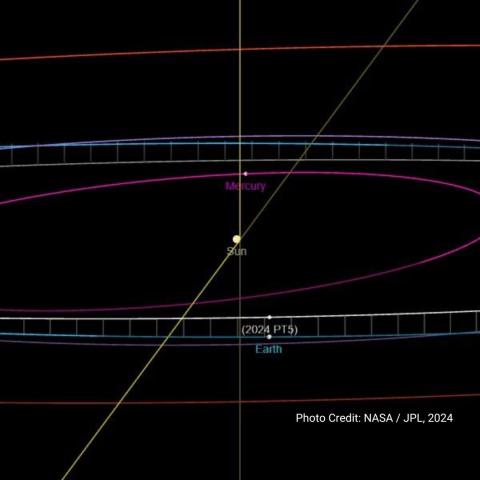Astronautical Anomaly: October Brings Two Moons to Earth
October 14, 2024The focus of both ancient and modern exploration, the moon’s place in the sky has captivated minds since humans first looked up. This October and November, we are being provided with some truly amazing celestial events. In addition to the aurora borealis that was unusually visible in our more southern states last week, an asteroid has been temporarily captured by our Earth's gravity and is so close that it appears as a second “mini moon” in the night sky. While the idea of having two moons might sound like science fiction, this event is based on real scientific predictions and calculations.
The Mini Moon's Arrival
The "mini moon" is set to orbit Earth from September 29 to November 25. First discovered earlier this year, it measures only about 33 feet across, about the size of a school bus, which is tiny compared to the size of the moon at about 2,159.2 miles in diameter. Space.com states that "the 'mini-moon' is actually the tiny asteroid 2024 PT5, which usually orbits the sun as part of a small asteroid belt that follows Earth."
During its orbit, this "mini moon" asteroid will trace a horseshoe-shaped path around our planet as if it were our moon. Its trajectory has been closely monitored by astronomers, who expect it to be relatively unstable. It is likely to escape Earth's gravitational pull after a relatively short period of time as it’s pulled away by other gravitational forces in our solar system. Regardless of the length of its stay, PT5 provides a stunning sight for those with the right equipment to view it. While it is too small and dim to see with the naked eye, it can be seen using a professional telescope. Earth.com suggests that “a telescope with a diameter of at least 30 inches plus a CCD or CMOS detector is needed to observe this object; a 30-inch telescope and a human eye behind it will not be enough.”
Near Earth Objects on Radar
Although fascinating, the concept of a “mini moon” isn't entirely new. Occasionally, asteroids and comets get nudged by the gravitational pull of nearby planets, causing them to enter Earth's neighborhood. As such, these near-Earth objects (NEOs) can become prominently viewed in our night sky for a short time. They originate from the asteroid belt or other regions of the solar system and find themselves on intersecting orbits with Earth. NEOs come in various sizes, from tiny pebbles to substantial space rocks. While most NEOs pose no threat to our planet, some can pose catastrophic risk to our planet, which is why initiatives like the DART mission are performed to prepare in cases of imminent disaster. NEOs have become crucial subjects of study for astronomers and planetary scientists, especially when they cross Earth's path. In fact, one study has predicted that “on Friday, April 13, 2029, an asteroid wider than three football fields will pass closer to Earth than anything its size has come in recorded history.” These events highlight the dynamic nature of our solar system and the constant movement of celestial bodies. It’s also a testament to the advanced capabilities of modern astronomy that we are able to detect and track these objects and predict their future paths.
Space Exploration and Observatory at Capitol Tech
Capitol Technology University’s ALPHA Observatory is a unique asset with our Astronautical and Space Engineering program that enhances student learning and contributes to our understanding of NEOs. This powerful instrument allows students to observe celestial objects, including NEOs like 2024 PT5, using an impressive 11-inch Celestron telescope configured for F/2 observations.
ALPHA enables students to gain practical experience with observatory equipment, data collection, and space research operations. They learn to track NEOs, analyze their orbits, and contribute to studies being performed by the Minor Planet Center (MPC). In collaboration with Capitol's Space Flight Operations Training Center (SFOTC), students become prepared for future space missions and ground control procedures.
The appearance of a second moon in the night sky is a remarkable event that reminds us of the wonders of the universe and the importance of scientific exploration. As we continue to study and monitor near-Earth objects, we can gain a deeper understanding of our place in the cosmos and the challenges and opportunities that lie ahead.
To learn more about our program offerings, contact our Admissions team or request more information.



